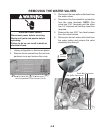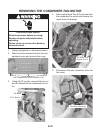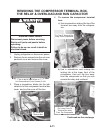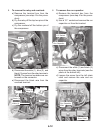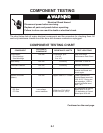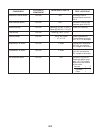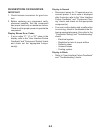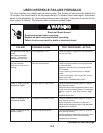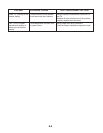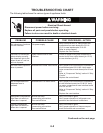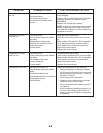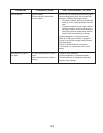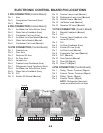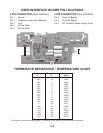
6-3
FAILURE
The refrigerator is OFF.
POSSIBLE CAUSE TEST PROCEDURE—ACTION
No lights inside the refrig-
erator.
No display indicators
except “.” dots in both
temperature displays.
No indicators illuminate
on user interface.
Unit may or may not be
cooling.
Code “d” blinking on the
refrigerator display.
Code “C” blinking on the
refrigerator display.
Code “C” blinking on the
freezer display.
No power to the user interface
from the control board.
Air door stuck or open circuit.
Freezer thermistor failure.
Press the ON/OFF keypad for two seconds to
turn the unit ON.
Unplug refrigerator or disconnect power.
Check circuits/connectors from control board
to user interface.
Attempt to turn ON unit by pressing the ON/
OFF keypad.
If unit is cooling, control board is in default
mode.
If unit is not cooling, unit may be OFF with no
way to turn it ON.
Refer to the “Troubleshooting Chart.”
Perform resistance checks (refer to “Compo-
nent Testing” section).
Verify the proper wire connections to the air door
motor and control board. Refer to “Component
Testing,” page 5-1, and “Strip Circuits,” page
7-3.
Replace the air door.
Perform resistance checks (refer to “Compo-
nent Testing” section).
Verify the proper connections to the main
board and the resistance value of the thermistor.
Replace the main board.
Perform resistance checks (refer to “Compo-
nent Testing” section).
Verify the proper connections to the main board
and the resistance value of the thermistor.
Replace the main board.
Refrigerator thermistor failure.
USER INTERFACE FAILURE FEEDBACK
The User Interface can display several failure codes. The display will only show the code(s) for
10 minutes, then revert back to the set temperature(s). To access these codes again, disconnect
power to the refrigerator for 10 seconds and then power it up again. It may take 3 minutes for the
error code(s) to display. The following table summarizes these codes.
Electrical Shock Hazard
Disconnect power before servicing.
Replace all parts and panels before operating.
Failure to do so can result in death or electrical shock.
WARNING
Continued on the next page.



